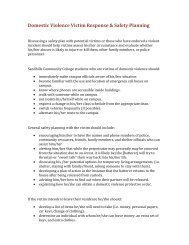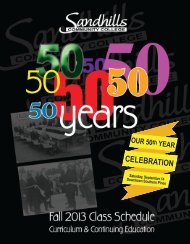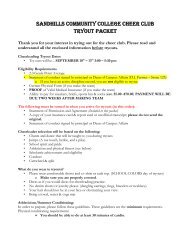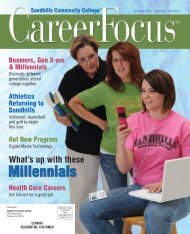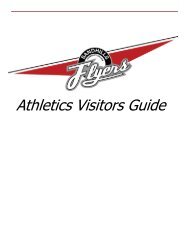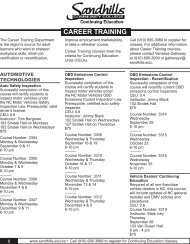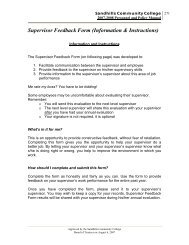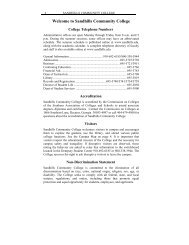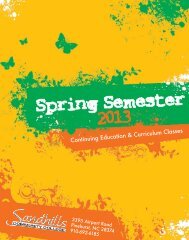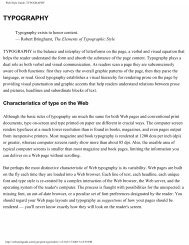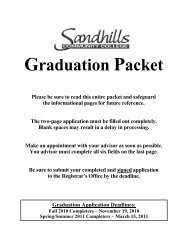1 The Enjoyment of Music 9th Shorter Edition
1 The Enjoyment of Music 9th Shorter Edition
1 The Enjoyment of Music 9th Shorter Edition
Create successful ePaper yourself
Turn your PDF publications into a flip-book with our unique Google optimized e-Paper software.
<strong>The</strong> <strong>Enjoyment</strong> <strong>of</strong> <strong>Music</strong><br />
9 th <strong>Shorter</strong> <strong>Edition</strong><br />
Module Two: Medieval<br />
and Renaissance <strong>Music</strong><br />
11. <strong>The</strong> Culture <strong>of</strong> the Middle Ages<br />
• Spans nearly 1,000 years<br />
400 – 600 Early Christian Period<br />
600 – 850 Early Middle Ages<br />
850 – 1150 Romanesque Period<br />
1150 – 1300 Ars Antiqua Period<br />
1300 – 1450 Ars Nova Period<br />
• Early Christian church and state were centers<br />
<strong>of</strong> powers<br />
• Most patronage (sponsorship) came from the<br />
Catholic church<br />
• Most surviving music is sacred<br />
12. Sacred <strong>Music</strong> in the Middle Ages<br />
<strong>The</strong> Catholic Mass<br />
• Liturgy: set order <strong>of</strong> early church services<br />
• Gregorian chant – Plainchant – Plainsong<br />
– Early church music<br />
– Monophonic texture<br />
– Syllabic text setting<br />
– Melismatic text setting<br />
– Latin text<br />
• Early notation: Neumes suggested the<br />
contours <strong>of</strong> the melody but not durations<br />
• Scale patterns used are church modes<br />
• Two divisions:<br />
– Proper: texts change according to the day<br />
– Ordinary: texts are the same for every Mass<br />
• Forms <strong>of</strong> music:<br />
– Responsorial: soloist alternates with chorus<br />
– Antiphonal: alternating singing by two<br />
separate groups<br />
1
Hildegard von Bingen (1098–1179)<br />
Hildegard: Alleluia, O virga<br />
mediatrix (Listening Guide)<br />
• 1150 founded a convent in Rupertsberg, Germany<br />
• Known for miracles and prophecies<br />
• Three collections <strong>of</strong> visions and prophecies<br />
in manuscript<br />
• Composed religious poetry with music<br />
• From the Proper <strong>of</strong> the Mass<br />
• Proper to the feast <strong>of</strong> the Virgin Mary<br />
• Ternary form (A-B-A)<br />
• Responsorial<br />
• Monophonic texture<br />
• Conjunct melody with few leaps<br />
• Free, nonmetric rhythm<br />
• Neumatic notation<br />
<strong>The</strong> Rise <strong>of</strong> Polyphony:<br />
<strong>The</strong> Notre Dame School<br />
Notre Dame School Organum:<br />
Gaude Maria virgo (Listening Guide)<br />
• Early Polyphony emerged at the Cathedral <strong>of</strong><br />
Notre Dame in Paris<br />
• Polyphony evolved toward the end <strong>of</strong> the<br />
Romanesque period (c. 850–1150)<br />
• Polyphony necessitated the use <strong>of</strong> notated<br />
rhythm and pitch<br />
• Organum: earliest polyphonic music<br />
• Léonin: earliest known composer <strong>of</strong> the Notre<br />
Dame School<br />
• Pérotin: Léonin’s successor, added two and<br />
three melodies to chant<br />
• Text praises Virgin Mary<br />
• Two-voice organum in the style <strong>of</strong> Pérotin<br />
• Both voices sing same text<br />
• Second added melody is melismatic<br />
• Original melody is a Gregorian chant,<br />
in slow sustained rhythm<br />
• Vox principalis (original chant)<br />
• Vox organalis (new melody)<br />
2
<strong>The</strong> Early Medieval Motet<br />
13. Secular <strong>Music</strong> in the Middle Ages<br />
• New text was added to second melody<br />
(vox organalis part) in melismatic organum<br />
• Created new genre: Motet<br />
• Many three-voice motets have different texts<br />
(polytextual)<br />
• Can be sacred or secular<br />
• Can have an instrumental accompaniment<br />
• A Gregorian chant is the basis for motets; the<br />
other voices are composed around the chant<br />
• Medieval Minstrels<br />
• Secular music in courts<br />
• Aristocratic artists<br />
– France: Troubadours, Trouvères<br />
– Germany: Minnesingers<br />
• Secular music in cities<br />
• Wandering minstrels: Goliards, Jongleurs<br />
• Idealized love and chivalry<br />
• Secular songs sung monophonically, with<br />
improvised accompaniment<br />
Guillaume de Machaut (1300–1377)<br />
Machaut: Puis qu’en oubli<br />
(Listening Guide)<br />
• French composer<br />
• Premier composer <strong>of</strong> Ars Nova (1300-1450)<br />
• Double career as cleric (sacred) and courtier<br />
(secular)<br />
• Poet and composer<br />
• Composed motets, chansons, and polyphonic<br />
Mass settings<br />
• Three-voice chanson (song)<br />
• Text: rondeau form (fixed form)<br />
• Pain <strong>of</strong> unrequited love<br />
• Low melodic range (depths <strong>of</strong> despair)<br />
3
Early Instrumental <strong>Music</strong><br />
14. <strong>The</strong> Renaissance Spirit<br />
<strong>Music</strong> in Renaissance Society<br />
• Central role in art music reserved for vocal<br />
music<br />
• Instrumental music mostly improvised<br />
• S<strong>of</strong>t (bas) or loud (haut) instruments<br />
• Instruments categorized by their use (indoor<br />
or outdoor)<br />
• Shift from sacred to secular style<br />
• Renaissance musicians worked in churches,<br />
cities, and courts or in the trades <strong>of</strong> instrument<br />
building, printing, and music publishing<br />
• Merchant class become new music patrons<br />
• Emergence <strong>of</strong> amateur musicians in cultivated<br />
middle and upper classes<br />
Renaissance <strong>Music</strong>al Style<br />
15. Renaissance Sacred <strong>Music</strong><br />
<strong>The</strong> Early Renaissance Mass<br />
• Regarded as golden age <strong>of</strong> a cappella<br />
(unaccompanied) singing<br />
• Polyphony based on concept <strong>of</strong> continuous imitation<br />
(motives are exchanged between melodic lines)<br />
• Expressive device <strong>of</strong> word painting favored in<br />
secular music<br />
• Composers sometimes used cantus firmus (fixed<br />
melody) as the basis for new works<br />
• Large choral works <strong>of</strong>ten sung by pr<strong>of</strong>essional<br />
singers in church setting<br />
• Composers focused their polyphonic Mass<br />
settings on the Ordinary <strong>of</strong> the Mass<br />
– Kyrie, Gloria, Credo, Sanctus, and Agnus Dei<br />
• Mass sung in Latin, not vernacular (language<br />
<strong>of</strong> the country)<br />
• Early polyphonic settings <strong>of</strong> the Mass were<br />
based on fragments <strong>of</strong> Gregorian chant<br />
• Requiem Mass: Mass for the dead sung at<br />
funerals and memorial services<br />
4
<strong>The</strong> Motet in the Renaissance<br />
Josquin des Prez and the Motet<br />
• Renaissance motet had a single Latin text<br />
• Popularity <strong>of</strong> Marian motets (Virgin Mary)<br />
• Written for 3, 4, or more voices<br />
• Sometimes based on a Cantus firmus (original<br />
Gregorian chant)<br />
• Josquin des Prez<br />
• Called Josquin (1450–1521)<br />
• Franco-Flemish composer<br />
• Italian music career<br />
• Patrons (Italy)<br />
– Milan: Cardinal Ascanio Sforza<br />
– Ferrara: Ercole d’Este<br />
– Rome: Papal Choir member<br />
• Composed sacred and secular music<br />
Josquin: Ave Maria . . . virgo<br />
serena (Listening Guide)<br />
<strong>The</strong> Late Renaissance Mass<br />
• Renaissance motet<br />
• Explores combinations <strong>of</strong> voices and textures<br />
• Begins with a quotation <strong>of</strong> Gregorian chant<br />
• Majority <strong>of</strong> work is newly composed<br />
• Contrasting imitative vs. homorhythmic sections<br />
• Homorhythmic: all voices move together<br />
rhythmically<br />
• Protestant revolt lead by Martin Luther (1483–1546)<br />
• Counter-Reformation (1530s–1590s)<br />
• Council <strong>of</strong> Trent concerns:<br />
– Corruption <strong>of</strong> chant by embellishment<br />
– Use <strong>of</strong> certain instruments<br />
– Incorporation <strong>of</strong> popular music in Masses<br />
– Secularism <strong>of</strong> music<br />
– Irreverent attitude <strong>of</strong> church musicians<br />
• Council recommended a pure vocal style that<br />
respected the integrity <strong>of</strong> the sacred texts<br />
5
Palestrina and the<br />
Pope Marcellus Mass<br />
Palestrina: Pope Marcellus Mass,<br />
Gloria (Listening Guide)<br />
• Giovanni Pierluigi da Palestrina<br />
• Called Palestrina (1525–1594)<br />
• Italian composer, organist, and choirmaster<br />
• Member Sistine Chapel Choir (Pope Julius III)<br />
• Composed mostly sacred music<br />
• Satisfied the new strict music demands <strong>of</strong><br />
the Council <strong>of</strong> Trent<br />
• Probably performed a cappella<br />
• Written for six voice parts<br />
• Opens with a monophonic intonation<br />
• Choral sections are polyphonic<br />
• Text is clear and audible<br />
16. Renaissance Secular <strong>Music</strong><br />
<strong>Music</strong> in Court and City Life<br />
<strong>The</strong> Chanson<br />
• Pr<strong>of</strong>essional musicians entertained in courts<br />
and civic functions<br />
• Merchant class amateurs played and sang<br />
at home<br />
• Most popular instruments: lute, organ,<br />
harpsichord, and clavichord<br />
• Main genres: chanson and madrigal<br />
• Developed in Burgundy and France during<br />
the 15th century<br />
• Usually for 3 or 4 voices<br />
• Set to courtly love poems<br />
• Freer poetic structures<br />
• Culminating figure: Roland de Lassus<br />
(c.1532-1494)<br />
6
Instrumental Dance <strong>Music</strong><br />
<strong>The</strong> Italian Madrigal<br />
• Period <strong>of</strong> growth in instrumental music<br />
• Published music was readily available<br />
• Instrumentation was unspecified<br />
• <strong>The</strong> occasion dictated the ensemble<br />
(indoor or outdoor)<br />
• Dances were <strong>of</strong>ten vocal works that were<br />
played instead <strong>of</strong> sung<br />
• Chief form <strong>of</strong> Renaissance secular music<br />
• Text: short poem <strong>of</strong> lyric or reflective nature<br />
• <strong>Music</strong>: sets text expressively<br />
• Instruments could double or substitute<br />
for some <strong>of</strong> the voices<br />
• Three periods <strong>of</strong> the madrigal:<br />
– First period (c. 1525–1550)<br />
– Second period (c. 1550–1580)<br />
– Third period (c. 1580–1620)<br />
Farmer and <strong>The</strong> English Madrigal<br />
Farmer: Fair Phyllis<br />
(Listening Guide)<br />
• Composers in England further developed<br />
the Italian madrigal<br />
• English madrigals were <strong>of</strong>ten simpler and<br />
lighter in style than Italian madrigals<br />
• John Farmer (1570–1601)<br />
– Active in 1590s in Dublin<br />
– Organist and master <strong>of</strong><br />
choirboys at Christ Church<br />
• Cheerful mood<br />
• Sectional repetitions<br />
• Contrapuntal imitation<br />
• Contrasting textures<br />
– Homorhythmic<br />
– Polyphonic<br />
• World painting (“Up and down…”)<br />
7
Medieval and Renaissance <strong>Music</strong><br />
Transition I: From<br />
Renaissance to Baroque<br />
• Polychoral <strong>Music</strong> in Venice<br />
• St. Mark’s Basilica<br />
• Choirmasters and organists<br />
• Byzantine architecture<br />
– Polychoral music<br />
– Antiphonal performance<br />
8



